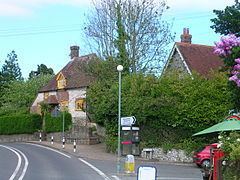Population 420. 2011 Census Civil parish Cocking Area 10.16 km² | OS grid reference SU878176 Sovereign state United Kingdom Dialling code 01730 | |
 | ||
Cocking is a village and civil parish in the Chichester district of West Sussex, England. The village is about three miles (5 km) south of Midhurst on the main A286 road to Chichester.
Contents
Map of Cocking, UK
In the 2001 census there were 190 households with a total population of 459 of whom 223 were economically active.
History and notable buildings
The 11th century Anglican parish church had no known dedication until 2007 when it was dedicated to St. Catherine of Siena.
In the centre of the village, on the corner of Mill Lane stands the old school, which is now a private residence. This was built in 1870 to the designs of architects Richard Carpenter and William Slater. The school has Gothic-style windows and door arches, is faced in flint with a red tiled roof and decorative barge-boards to the gables. The former schoolmaster's house has a distinctive chimney-stack with four outlets.
To the south of the village are the remains of Cocking Lime Works, abandoned in 1999, and the associated chalk pit, while to the north are a few traces of the Chorley Iron Foundry, which cast the waterwheels now at the Weald and Downland Open Air Museum and at the Coultershaw Beam Pump.
There still remain in the village some houses of 17th century origin. In 1931 the population of the village was 431.
There was a Richard Cobden pub in Cocking which closed and became a private residence in the 20th century. Cobden lived in nearby Heyshott.
Transport
A railway once used to serve the area at Cocking Station, on the Chichester to Midhurst line opened in 1880, but was completely closed from 1953. The village is on the Stagecoach South No.60 bus route which runs from Midhurst to Chichester.
Today
A number of buildings in the village belong to the Cowdray Estate, distinguished by their external woodwork painted yellow.
The remaining village pub, formerly The Blue Bell, became a restaurant with accommodation called The Bluebell Inn, and stands on the corner of Bell Lane.
Cocking is on the South Downs Way long-distance footpath.
